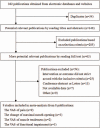Acupuncture therapy in the management of the clinical outcomes for temporomandibular disorders: A PRISMA-compliant meta-analysis
- PMID: 28248862
- PMCID: PMC5340435
- DOI: 10.1097/MD.0000000000006064
Acupuncture therapy in the management of the clinical outcomes for temporomandibular disorders: A PRISMA-compliant meta-analysis
Abstract
Purpose: The purpose of this study was to evaluate conventional acupuncture therapy in the management of clinical outcomes for temporomandibular disorders (TMD) in adults.
Methods: The electronic databases PubMed, EMBASE, Cochrane Central Register of Controlled Trials, and Clinical Trails.gov were searched for reports published until March 31, 2016.
Results: Nine eligible studies from 8 publications involving 231 patients were included in the meta-analysis. A comparison of the main outcome of visual analog scale (VAS) values of pain between the acupuncture group and control group showed a significant decrease (MD = -0.98, 95% CI [-1.62, -0.34], I=54%, P = 0.003) in the VAS following acupuncture treatment. However, subgroup analysis according to the type of sham control group indicated that there were significant differences in the results when sham acupuncture was used as the control group (MD = -1.54, 95% CI [-2.63, -0.45], I=58%, P = 0.006) as well as when sham laser treatment was used as the control group (MD = -1.29, 95% CI [-2.32, -0.27], I = 0%, P = 0.01). However, there was no significant difference when the splint treatment group was used as the control group (MD = -0.09, 95% CI [-0.69, 0.50], I = 0%, P = 0.76). Subgroup analyses of VAS for pain by the classification of diseases indicated that the myogenous TMD subgroup demonstrated a significant difference (MD = -1.49, 95% CI [-2.45, -0.53], I = 47%, P = 0.002), and TMD showed no statistically significant difference (MD = -0.42, 95% CI [-1.14, 0.30], I = 46%, P = 0.25). Subgroup analysis according to whether the subgroup penetrated the skin showed that nonpenetrating sham acupuncture as the control group showed a significant difference (MD = -1.56, 95% CI [-2.70, -0.41], I = 58%, P = 0.008) compared with the conventional acupuncture as the treatment modality, while penetrating sham acupuncture as the control group showed no significant difference (MD = -1.29, 95% CI [-3.40, 0.82], I = not applicable, P = 0.23). No publication bias was observed considering the symmetry of the funnel plots.
Conclusions: Our results indicate that conventional acupuncture therapy is effective in reducing the degree of pain in patients with TMD, especially those with myofascial pain symptoms.
Conflict of interest statement
The authors have no conflicts of interest to disclose.
Figures








Similar articles
-
Temporomandibular disorders and the use of traditional and laser acupuncture: a systematic review.Cranio. 2023 Nov;41(6):501-507. doi: 10.1080/08869634.2021.1873605. Epub 2021 Jan 12. Cranio. 2023. PMID: 33433268
-
Efficacy of splint therapy for the management of temporomandibular disorders: a meta-analysis.Oncotarget. 2016 Dec 20;7(51):84043-84053. doi: 10.18632/oncotarget.13059. Oncotarget. 2016. PMID: 27823980 Free PMC article. Review.
-
Efficacy of acupuncture and laser acupuncture in temporomandibular disorders: a systematic review and meta-analysis of randomized controlled trials.BMC Oral Health. 2024 Feb 3;24(1):174. doi: 10.1186/s12903-023-03806-1. BMC Oral Health. 2024. PMID: 38308258 Free PMC article.
-
Is acupuncture an effective treatment for temporomandibular disorder?: A systematic review and meta-analysis of randomized controlled trials.Medicine (Baltimore). 2023 Sep 22;102(38):e34950. doi: 10.1097/MD.0000000000034950. Medicine (Baltimore). 2023. PMID: 37746950 Free PMC article.
-
Comparison of Acupuncture and Sham Acupuncture in Migraine Treatment: An Overview of Systematic Reviews.Neurologist. 2022 May 1;27(3):111-118. doi: 10.1097/NRL.0000000000000386. Neurologist. 2022. PMID: 34842579 Free PMC article. Clinical Trial.
Cited by
-
Myogenous Temporomandibular Disorders: Diagnostic Concepts and Prospective Pilot Study on Extracorporeal Shockwave Therapy.Diagnostics (Basel). 2022 Dec 24;13(1):51. doi: 10.3390/diagnostics13010051. Diagnostics (Basel). 2022. PMID: 36611343 Free PMC article.
-
Acupuncture for Chronic Pain in the Vermont Medicaid Population: A Prospective, Pragmatic Intervention Trial.Glob Adv Health Med. 2018 Apr 10;7:2164956118769557. doi: 10.1177/2164956118769557. eCollection 2018. Glob Adv Health Med. 2018. PMID: 29662722 Free PMC article.
-
Effectiveness of Laser Acupuncture for Reducing Pain and Increasing Mouth Opening Range in Individuals with Temporomandibular Disorder: A Systematic Review and Network Meta-Analysis.Curr Pain Headache Rep. 2024 Jul;28(7):723-742. doi: 10.1007/s11916-024-01251-5. Epub 2024 Apr 22. Curr Pain Headache Rep. 2024. PMID: 38648000
-
Efficacy of acupuncture on craniomandibular myofascial pain in temporomandibular disorder patients: A systematic review.Heliyon. 2024 May 31;10(13):e32075. doi: 10.1016/j.heliyon.2024.e32075. eCollection 2024 Jul 15. Heliyon. 2024. PMID: 39091957 Free PMC article.
-
A randomized clinical trial comparing the efficacy of low-level laser therapy (LLLT) and laser acupuncture therapy (LAT) in patients with temporomandibular disorders.Lasers Med Sci. 2020 Feb;35(1):181-192. doi: 10.1007/s10103-019-02837-x. Epub 2019 Aug 8. Lasers Med Sci. 2020. PMID: 31396794 Clinical Trial.
References
-
- Goldstein BH. Temporomandibular disorders: a review of current understanding. Oral Surg Oral Med Oral Pathol Oral Radiol Endod 1999;88:379–85. - PubMed
-
- Magnusson T, Egermark I, Carlsson GE. Treatment received, treatment demand, and treatment need for temporomandibular disorders in 35-year-old subjects. Cranio 2002;20:11–7. - PubMed
-
- Al-Jundi MA, John MT, Setz JM, et al. Meta-analysis of treatment need for temporomandibular disorders in adult nonpatients. J Orofac Pain 2008;22:97–107. - PubMed
-
- Dworkin SF, Huggins KH, LeResche L, et al. Epidemiology of signs and symptoms in temporomandibular disorders: clinical signs in cases and controls. J Am Dent Assoc 1990;120:273–81. - PubMed
-
- Chen YW, Chiu YW, Chen CY, et al. Botulinum toxin therapy for temporomandibular joint disorders: a systematic review of randomized controlled trials. Int J Oral Maxillofac Surg 2015;44:1018–26. - PubMed
Publication types
MeSH terms
LinkOut - more resources
Full Text Sources
Other Literature Sources
Medical

